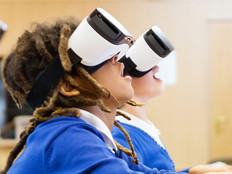Holographic Tech Could Be the Next Big AR Offering in K–12 Classrooms
Holograms have become somewhat less of an anomaly since Michael Jackson’s image moonwalked across the Billboard Music Awards stage four years ago — and in time, the technology could start showing up in K–12 classrooms.
Often referred to as a type of augmented reality, holographic technology allows viewers to see virtual objects projected into their physical space.
To date, Microsoft’s HoloLens — a wireless headset introduced in 2015 — has been the most prominent holographic product on the marketplace. Data collected from audio and visual sensors help shape multidimensional digital models HoloLens users can interact with; HD lenses use an advanced optical projection system to generate the images.
The wireless system lets users move around freely and communicate with each other, according to Dan Ayoub, general manager of mixed reality education for Microsoft.
“You’re completely untethered,” Ayoub says. “Spatially, you and I could both have devices on, working on a problem together; you can see what I’m seeing and mark up my field of view.”
SIGN UP: Get more news from the EdTech newsletter in your inbox every two weeks!
Augmented Reality Fast Forwards the Learning Process
Although the current price point — roughly $3,000 — has made HoloLens a more popular choice for enterprises and universities, the technology has a number of potential K–12 applications.
“We’ve aggregated a number of studies, and we’ve done our own, that show academic performance and engagement improves,” Ayoub says. “We’re effectively 3D beings, and in many cases, you’re trying to understand complex scenarios in 2D, which doesn’t always make sense. These devices enable all kinds of 3D learning opportunities.”
Case Western Reserve University, a participant in an early HoloLens pilot, says Ayoub, has utilized the technology to teach electromagnetics and physics. In November, sparks and other holographic elements illuminated the stage during a dance department performance.
Devices are primarily used, however, for medical school anatomy sessions, says Mark Griswold, professor of radiology at CWRU’s School of Medicine and faculty leader of the university’s Interactive Commons research center.
“We received some initial data that students were learning anatomical structures at the same level as they were in the cadaver lab,” Griswold says.
Visualize Hologram Cost and Planning in the Classroom
Hypothetically, the technology could be used to illustrate concepts to younger students, Griswold says. For example, he wishes a centurion could have been circling the classroom when his son was learning about Roman history in seventh grade.
“Seeing a shield and sword is so much more engaging than looking at photos in a book,” he says. “You could sit next to Thoreau at Walden Pond; name a historical era — you could do amazing things.”
Schools, however, need to carefully consider how a big-ticket holographic tech purchase will affect other district resources, says Jaime Donally, a former math teacher and author of Learning Transported: Augmented, Virtual and Mixed Reality for All Classrooms.
“It often requires instruction and technical support on multiple campuses. Somebody has to maintain the calendar and keep the devices clean,” Donally says. “As cool as it is, you need to think through technology like this practically. How would it be implemented?”
Although the exact time frame remains unclear, Ayoub expects K–12 adoption will be more likely as holographic technology becomes more affordable.
“Like any technology, things get less expensive over time,” he says. “As the price gets closer to the price for a virtual reality system, I expect more people to go to augmented reality. It has a more collaborative nature — the potential is so powerful for education.”









